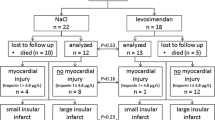Abstract
Current research suggests that cerebral ischemia induces a cascade of pathophysiological reactions, with a massive influx of calcium into the neuron as the “final common pathway”, resulting in catabolism and cell necrosis due to calcium overload. Treatment with calcium entry blockers, therefore, may be a new approach to arresting, and possibly preventing, destruction of cerebral tissue in stroke patients. The calcium entry blocker nimodipine was found to inhibit selectively spasms of the isolated cerebral arteries, produced either by depolarization or by receptor stimulation. In vivo experiments demonstrated that postischemic impairment of cerebral blood flow, which may be a major contributor to neuronal damage, is prevented.
After encouraging, although not conclusive, results of a single-blind pilot study, further clinical studies were undertaken and a double-blind, placebo-controlled, multicenter study was conducted. The data from this study strongly suggest that patients with acute ischemic stroke benefit from treatment with 120 mg nimodipine, started with 24 h after onset, combined with a “Standard” treatment, e. g., hemodilution by low molecular weight dextran. The conclusion so far is that calcium entry blockers such as nimodipine, may be useful in the treatment of patients with acute ischemic stroke.
Preview
Unable to display preview. Download preview PDF.
Similar content being viewed by others
References
Hossmann KA, Zimmerman V (1974) Resuscitation of brain after one hour of complete ischemia. Brain Res 81: 59–74
Astrup J, Symon L, Branston NM, Lassen NA (1979) Cortical evoked potentials of brain ischemia. Stroke 8: 51–57
Astrup J, Siesjo BK, Symon L (1981) Thresholds in cerebral ischemia. The ischemic penumbra. Stroke 12: 723–725
Siesjo BK (1981) Cell damage in the brain: a speculative hypothesis. J Cereb Blood Flow Metab 1: 155–186
Hass WK (1981) Beyond cerebral blood flow, metabolism and ischemic thresholds: an examination of the role of calcium in the initiation of cerebral infarction. In: Meyer JS, Lechner H, Reivich M, Ott EO, Arabinar A (eds) Cerebral vascular disease, vol 3, Proceedings of the 10th Salzburg conference on cerebral vascular disease. Exerpta Medica, Amsterdam, pp 3–17
Godfraind T (1984) Basic mechanisms and classification of calcium entry blockers. In: Godfraind T, Herman AG, Wellens D (eds) Calcium entry blockers in cardiovascular and cerebral dysfunctions. Martinus Nijhoff, The Hague, pp 9–18
Towart R (1981) The selective inhibition of serotonin-induced contractions of rabbit cerebral vascular smooth muscle by calcium-antagonistic dihydropyridines. Circ Res 18: 650–657
White RP, Cunningham MP, Robertson JT (1982) Effect of the calcium antagonist nimodipine on the contractile responses of isolated canine basilar arteries induced by serotonin, prostaglandin F2a, thrombin and whole blood. Neurosurgery 10: 344–348
Kazda S, Garthoff B, Luckhaus G (1983) Calcium antagonists prevent brain damage in stroke prone spontaneously hypertensive rats. J Cereb Blood Flow Metab 3: 526–527
Kazda S, Hoffmeister F (1979) Effect of some cerebral vasodilators on the postischemic impaired cerebral perfusion in cats. Acta Pharmacol (Suppl)307: R43
Kazda S, Garthoff B, Krause WP, Schlossman K (1982) Cerebrovascular effects of the calcium antagonistic dihydropyridine derivate nimodipine in animal experiments. Arzneimittelforsch 32: 331–338
Steen PA, Newberg LA, Milde JH, Michenfelder JD (1983) Nimodipine improves cerebral blood flow and neurologic recovery after complete ischemia in the dog. J Cereb Blood Flow Metab 3: 38–43
Newberg LA, Steen PA, Milde JH et al. (1984) Effects of nimodipine on cerebral blood flow and neurologic function following complete global ischemia in dogs and primates. In: Betz E, Deck K, Hoffmeister F (eds) First international nimotop symposium. Schattauer, Stuttgart, pp 99–10
Taylor DG, Kowalski TE (1984) Comparison of calcium channel inhibitors on vagal heart rate responses elicited by arterial baroreceptor reflexes in anaesthesized dogs. J Pharmacol Exp Ther 228: 491–499
Paulson OB, Lassen NA, Skinhoj E (1970) Regional cerebral blood flow in apoplexy without arterial occlusion. Neurology 20: 125–138
Lassen NA (1966) The luxury perfusion syndrome and its possible relation to acute metabolic acidosis localised within the brain. Lancet ii:1113 –1116
Fieschi C, Aguoli A, Principe M, Battistini N, Bozzao L, Nardini M (1969) Impairment of the regional vasomotor response of central vessels to hypercarbia in vascular diseases. Eur Neurol 2: 13–20
Paulson OB, Lassen MA, Skinhoj E (1970) Regional cerebral blood flow in apoplexy without atrial occlusion. Neurology 20: 125–138
Gaab MR, Brawanski A, Bockhorn J, Maximilian VA (1982) Calcium antagonism: a new therapeutic principle in stroke and cerebral vasospasm? Reg Cerebral Blood Flow Bull (Novo Copenhagen) 3: 47–51
Gelmers HJ (1982) Effect of nimodipine on postischemic cerebrovascular reactivity, as revealed by measuring regional cerebral blood flow (rCBF). Acta Neurochir 63: 283–290
Gelmers HJ (1984) The effect of nimodipine on the clinical course of patients with acute ischemic stroke. Acta Neurol Scand 69: 232–239
Gelmers HJ, Gorter K, de Weerdt CJ, Wiezer HJA (1985) Acute ischemic stroke: a controlled trial with the calcium antagonist nimodipine. J Cereb Blood Flow Metab 5 (suppl 1): S337
Schanne FAK, Kane AB, Young EE et al. (1979) Calcium dependence of toxic cell death: a final common path. Science 20: 700–702
Capildeo R, Haberman S, Rose CF (1982) Stroke trials: the facts. In: Rose CF (ed) Advances in stroke therapy. Raven, New York, pp 53–62
Hinds CJ (1985) Brain ischemia. Br Med J 291: 758–760
Mathew NT, Meyer JS, Rivera VH (1972) Double blind evaluation of glycerol treatment in acute cerebral infarction. Lancet ii: 1327–1333
Gelmers HJ (1975) Effect of glycerol treatment on the natural history of acute cerebral infarction. Clin Neurol Neurosurg 78: 277–282
Wood JH, Kee DB Jr (1985) Hemorrheology of the cerebral circulation in stroke. Stroke 16: 765–772
Author information
Authors and Affiliations
Editor information
Editors and Affiliations
Rights and permissions
Copyright information
© 1987 Springer-Verlag Berlin Heidelberg
About this chapter
Cite this chapter
Gelmers, H.J., Wiezer, J.H.A., de Weerdt, C.J., Gorter, K. (1987). Effect of Nimodipine on the Cerebral Circulation and Acute Ischemic Stroke. In: Poeck, K., Ringelstein, E.B., Hacke, W. (eds) New Trends in Diagnosis and Management of Stroke. Springer, Berlin, Heidelberg. https://doi.org/10.1007/978-3-642-72996-6_11
Download citation
DOI: https://doi.org/10.1007/978-3-642-72996-6_11
Publisher Name: Springer, Berlin, Heidelberg
Print ISBN: 978-3-540-18369-3
Online ISBN: 978-3-642-72996-6
eBook Packages: Springer Book Archive




